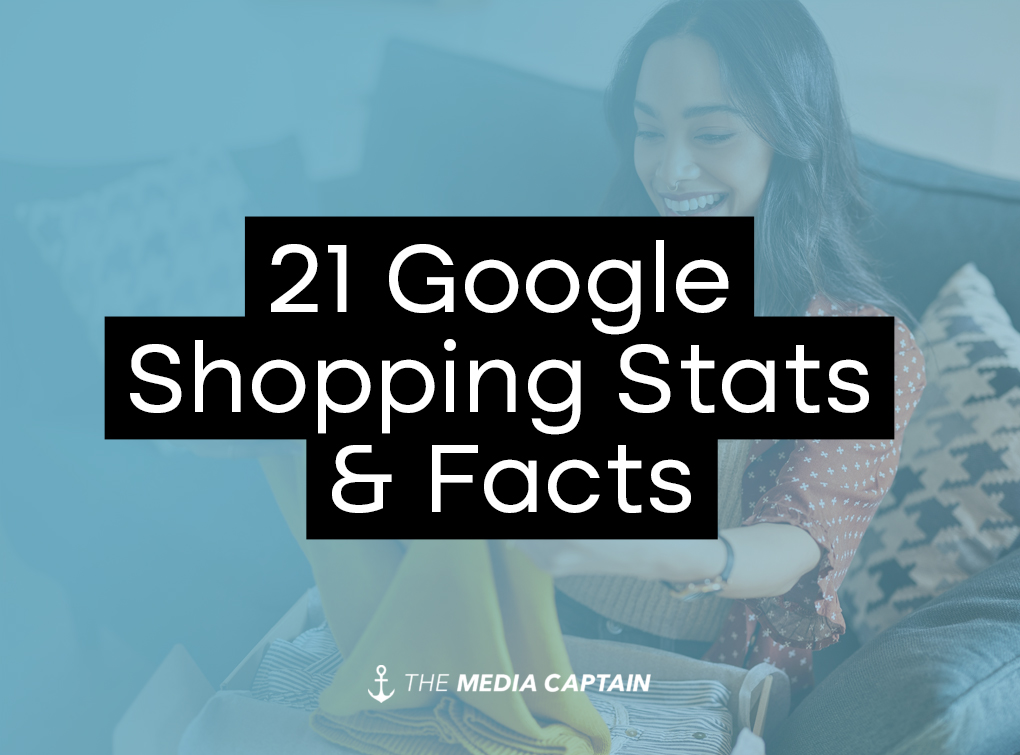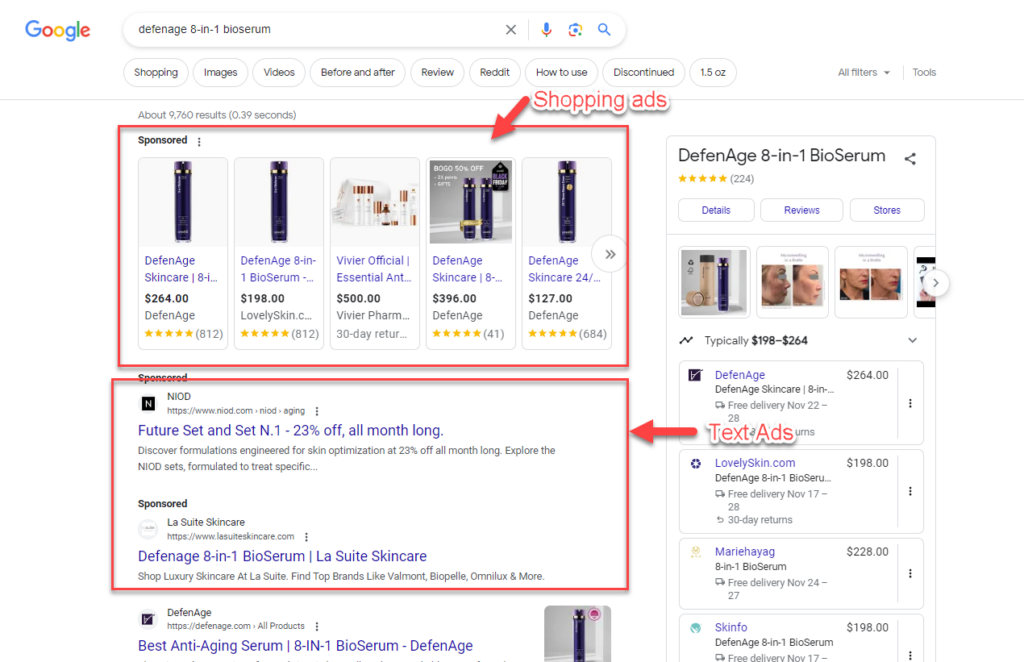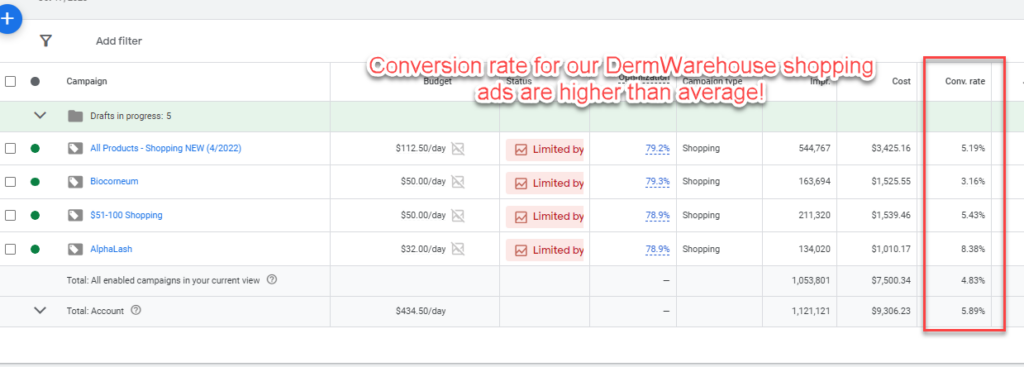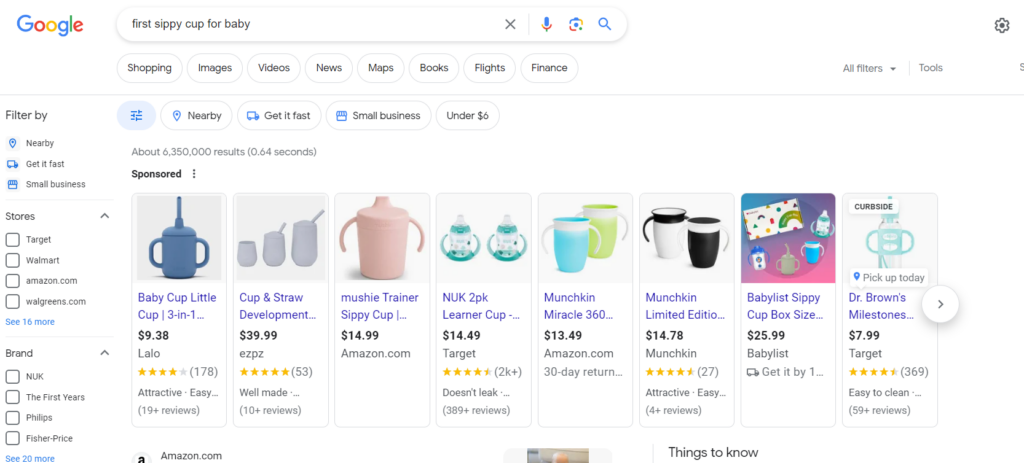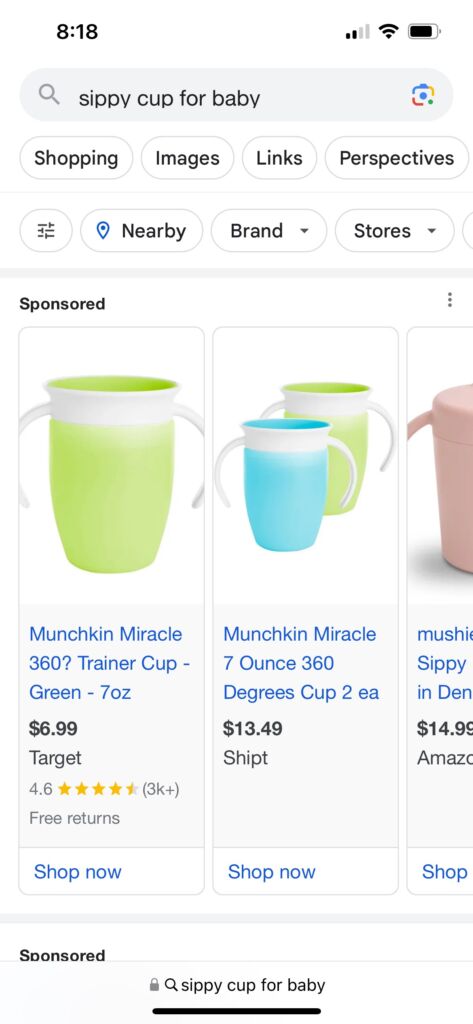Google shopping ads are advertisements that showcase your products with images, names, prices, and reviews at the very top or on the right hand side of Google search. When it comes to product searches, this is prime real estate! Many people are surprised to learn that Google Shopping Ads tend to be 30% less expensive than standard text ads! Once you launch Google Shopping for your eCommerce brand, you can drive immediate traffic to your store.
Our agency manages millions in ad spend for eCommerce clients. We also have our own in-house eCommerce brand in DermWarehouse. We’ve had great success running Shopping ads for our clients and for our own businesses. If you’re an eCommerce business and you’re not set up with shopping ads (which need to be set up via Merchant Center), it’s time to hit the ground running.
Learn More: How to Optimize Google Shopping Ads for a Better Return on Ad Spend
Google Shopping Ads vs. Text Ads
Unlike Google’s text ads, which populate on Google based on keywords you select within the campaign, shopping ads are all predicated based on the shopping feed and availability of products in your catalog. Products for your Google shopping campaigns are uploaded through your shopping feed in Google Merchant Center. Below is an example of what a Google Shopping advertisement looks like. We wanted to share this visual before diving into key Google Shopping statistics.
Google Shopping Statistics
We love sharing statistics about our different services with our clients, as these really help hit on the importance of the work that we’re doing and the impact that they have. Google shopping is a vital channel for eCommerce clients of ours. In addition to sharing great stats, we also love to share examples from DermWarehouse, so the list below is comprised of both.
The average cost per click of Google Shopping is $0.66, which is lower than the Google Ads average of $1.16 CPC for E-COMMERCE stores [1]
This statistic tells us that utilizing shopping ads can actually help lower your overall cost per click vs. just regular search ads. If you are diligent in managing your search terms within your shopping ads, these ads can be extremely targeted and yield great results with a lower average cost per click.
For DermWarehouse, our eCommerce skincare brand, we continue to see yearly increases in average cost per click for Google Shopping (see data below). Skin care is a very competitive industry so keep in mind that your average cost will depend on many different factors, including competitiveness, the maximum bid you’ve set (if any), your diligence in monitoring search terms, and more.
- 2019 Average CPC: $0.75
- 2020 Average CPC: $0.83
- 2021 Average CPC: $0.94
- 2022 Average CPC: $0.97
- 2023 Average CPC: $1.17
The average clickthrough rate of Google Shopping Ads is .86% [2]
According to Google, “Clickthrough rate (CTR) can be used to gauge how well your keywords and ads are performing. CTR is the number of clicks your ad receives divided by the number of times your ad is shown: clicks ÷ impressions = CTR. For example, if you had 5 clicks and 100 impressions, your CTR would be 5%.”
While CTR isn’t the main metric that we pay attention to in shopping ads for eCommerce clients (we look at the return on ad spend), if we’re seeing a low CTR, it typically means that improvements can be made to the ads. We always start by looking at the search terms and adding in negative keywords to ensure our ads aren’t showing for search terms that don’t make sense.
A standard budget allocation for Google Shopping vs. PPC for E-COMMERCE brands is 80% (Shopping) vs. 20% (PPC) [2]
Different budget allocations may make sense for different business types. For DermWarehouse, our percentage is closer to 50/50. We rely heavily on dynamic search ads and regular search ads to promote the brands we sell. With search campaigns, we’re able to carefully select which keywords we want to target. Since we sell products that are well known and people are searching for, we know exactly which keywords to target and we can create very customized ads for each of our brands. Make sure you pay attention to the data and see which type of ads are performing best. Allocate your budget based on this and you’ll be in good shape.
The average Google Shopping Ads conversion rate is 1.91% [5]
The average eCommerce conversion rate is about 2.5 – 3%, so the average Google Shopping conversion rate seems a little low. Below you’ll see the conversion rate for our DermWarehouse shopping ads. In addition to making sure that we keep a close eye on our ads, and especially our search terms, we also make a lot of optimizations on our site to try to increase our conversion rate. We enhance content on our product pages often, trying to include as much product information as possible. We work really hard to get product reviews. We also offer a discount for first time shoppers. We’re spending a lot of money to bring traffic to our website, so we want to do everything we can to get customers to convert.
Google Shopping has 1.2 billion monthly searches [4]
When I think about the value of Google shopping, I think about how often I personally shop online and click through products through the shopping ads. Not only do these ads have extremely prime real estate on Google, they also showcase everything you want to know about a product. From photos, to reviews to shipping information and more, they make shopping and decision making easy.
The average Google Shopping Ads budget is $770.41, though this varies significantly by industry [2]
One of my favorite aspects of advertising on Google is that it’s accessible to everyone. No matter your budget, you can get your products in front of customers. Even if you only have a few dollars to spend per day, this will help you drive initial traffic to your site. As you optimize your ads and see performance increase, you can scale your budget.
For DermWarehouse, we started with a modest $500/month budget. We started very slowly and as we saw orders come through and profitability increase, we were able to scale our campaigns. Now we spend north of $40,000 per month on our ads.
TIP: When you’re spending money to drive traffic to your site, make sure you have a great email marketing strategy in place to capture customer information so you can remarket to those who don’t convert right away!
Google has a market share of 92% while Bing has a 6% market share [5]
If you’re only spending money to advertise on one channel, Google is the place to be. In terms of popularity, it’s the obvious winner, however, the caveat to that is that there’s more competition and therefore average cost per click can be higher. While we definitely recommend starting on Google, don’t discount Bing just because it’s not as popular. We’ve seen some really great results on this channel for our clients. The best part is that you can easily import your ad campaigns directly from Google to Bing so the setup is extremely easy.
Learn More: Why the Pros Outweigh The Cons of Advertising on Bing
The average cost per click can be 70% lower on Bing versus Google [6]
See above for my thoughts on Bind advertising. It makes complete sense that due to lower popularity and less competition, you can get a better deal when bidding on search keywords. Some industries are extremely competitive on Google and if you’re just starting out and can’t afford the high CPCs there, it may be a good move to look to Bing.
Learn More: Powerful Bing Search Statistics
81% of all product searches start on Amazon or Google, 31.5 percent of which are on Google [16]
Amazon is growing in popularity and this is where a majority of consumers start their shopping search. That being said, there are a lot of downsides to selling on Amazon. Selling on Google and directing traffic to your own website is the best way to have full control of your products and your business. If you can sell on both channels, great, but if you’re focuing just on Amazon, make sure you’re diversified since there are a lot of question marks with that channel.
Shopping ads drive 76% of retail search ad spend, and generate 85% of all clicks on Google Ads or Google Shopping campaigns [9]
It makes complete sense that the majority of retail search ad spend and clicks go to shopping ads. Due to the visual nature of the ads, their placement on the page, and the information that comes along with them, many consumers don’t have a reason to continue scrolling down the page to the search ads. This goes hand in hand with the stat that advertisers spend 80% of their budget on shopping ads and 20% on search ads. That’s where the majority of sales are coming from!
Google Shopping is proven to have 30% higher conversion rates than text ads [10]
Between the higher conversion rate, lower cost per click, and the amount of revenue driven through shopping ads, they are a no-brainer for eCommerce businesses. There are some instances when shopping ads may not make sense, however. If you sell a more generic product, like t-shirts, for example, it may be really difficult to get exposure on shopping due to the highly competitive nature of the product and also the lack of specific search terms. There are so many retailers out there selling t-shirts and it will be hard to compete with the Targets of the world.
49% of shoppers surveyed say they use Google to discover new products [3]
I do this all the time. Any time I have a general idea of what I’m looking for and need to narrow down my search, I use Google Shopping to do so. Here are two recent examples. First, I was looking for a dress to wear to a wedding. I had no idea what kind of dress I wanted to wear, so I searched for long-sleeved wedding guest dresses and let Google help me find different styles and different brands. The second example is items for my son. I have a seven-month-old and I’m always looking for new products for him to help with different milestones that he’s going through. We met with our doctor this week and she said that she wanted him to start using a sippy cup. I had no idea what to look for in a sippy cup or even what was available, so I looked on Google to get ideas of what was out there.
As you can see in the image below, there are a lot of options and different types of cups available. My eyes immediately went to the NUK product from Target based on the number of reviews and the fact that it says it doesn’t leak.
95% of ad clicks on mobile devices go to Google Ads’ campaigns [12]
If you look on mobile, the Google Shopping ads are even more prevalent than on desktop. They are really all you can see! On mobile, you can see less real estate right off the bat, so most of the time, organic listings aren’t visible until you scroll down a little ways. It makes sense that consumers are going to be clicking on some of the first results that appear. Below is what my sippy cup search looks like on mobile.
More than 80% of global businesses trust Google Ads for PPC campaigns [13]
I’m surprised that this number isn’t higher. I’m not sure what’s not to trust when it comes to Google.
According to the latest earnings release by Alphabet, Google’s parent company, total worldwide revenue for Google in Q3 2023 came in at $76.7 billion, of which $59.6 billion was from Google advertising. [17]
From AI to computer software to its search engine technology and more, Google has a lot going on. As you can see, most of their revenue is coming from advertising. If these ads didn’t work, businesses wouldn’t be spending this much money on the platform.
Google Shopping has 1.2 billion monthly searches. [4]
That’s a lot of people searching and shopping on Google. There’s no doubt that Google can drive a ton of new traffic and business for your eCommerce store and this is just another stat to prove that.
Food & Drink had the highest conversion rate for paid search ads, at 9.74%. Sporting Goods experienced the lowest, at 2.68 [4]
HERE’s a great article that breaks down different Google shopping benchmarks by industry [2]. It’s really interesting to see the different ranges by industry. We’re in the beauty industry and this tends to be on the higher end for many categories.
63% of people have clicked on a Google ad [14]
We talked earlier about the fact that the majority of shopping searches begin on Amazon, but when it comes to clicks, “people are four times more likely to click on a paid search ad on Google (63%) than on any other search engine – Amazon (15%), YouTube (9%), and Bing (6%).” [17] Even if shoppers aren’t more likely to search on Google than Amazon, they are more likely to click on an ad there.
500,000+ online businesses use Google Merchant Center [18].
Merchant Center allows you to upload your shopping feed and gives you the ability to sell on Google Shopping. If you want to sell your products through shopping ads (along with the hundreds of thousands of other businesses doing so), this is where you’ll need to start!
In closing
- Google shopping is an extremely important channel for anyone operating an eCommerce business.
- So many consumers start their shopping search on Google. If you’re not visible there, then you’re missing out on a lot of potential business.
- When it comes to advertising on Google, you can’t beat the visibility of Google shopping ads. They’re front and center and extremely important real estate to take advantage of.
- Customers have a much higher purchase intent when shopping on Google vs. on social media channels.
- The statistics to back up the importance of Google shopping are staggering. This channel is one that can’t be missed for eCommerce.
SOURCES
1: StoreGrowers, 2. StoreGrowers, 3. GrowMyAds, 4. Renolon, 5. Backlinko, 6. Instapage, 7. KlientBoost, 8. Oberlo, 9. KlientBoost, 10. HubSpot, 11. GrowMyAds, 12. WebFX, 13. Website Rating, 14. Social Sheppard, 15. GrowMyAds 16. Search Engine Land 17. Oberlo 18. Google


